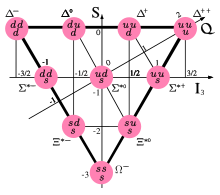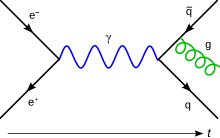History of quantum mechanics
Appearance

Left to right:
The history of quantum mechanics is a fundamental part of the history of modern physics, and has been portrayed to include two quantum revolutions.
Quotes
[edit]

- This book tells the story of the researches that are traditionally lumped together under the label "radiation theory" and revolving, loosely speaking around the familiar heat-and-light exchange (hot bodies emit light and radiate; the absorption of light, especially sunlight, is warming).
- Joseph Agassi, Radiation Theory and the Quantum Revolution (1993) Preface
- These days it is common knowledge that short waves are more powerful than long ones, as the very short ones, known as x-rays, damage living tissues. It took half-a-century to learn this fact: it was one of the great discoveries of young Albert Einstein of 1905. When he announced it leading researchers found it most incredible...
- Joseph Agassi, Radiation Theory and the Quantum Revolution (1993) p. 10
- The development of quantum mechanics in the beginning of the twentieth century was a unique intellectual adventure, which obliged scientists and philosophers to change radically the concepts they used to describe the world. After these heroic efforts, it became possible to understand the stability of matter, the mechanical and thermal properties of materials, the interaction of radiation and matter, and many other properties of the microscopic world that had been impossible to understand with classical physics. A few decades later, that conceptual revolution enabled a technological revolution, at the root of our information-based society. It is indeed with the quantum mechanical understanding of the structure and properties of matter that physicists and engineers were able to invent and develop the transistor and the laser—two key technologies that permit the high-bandwidth circulation of information, as well as many other scientific and commercial applications.
- Alain Aspect, "Introduction, John Bell and the second quantum revolution," Speakable and Unspeakable in Quantum Mechanics: Collected Papers on Quantum Philosophy by J. S. Bell (2004)
- The realization of the importance of entanglement and the clarification of the quantum description of single objects have been at the root of a second quantum revolution, and the John Bell was its prophet.
- Alain Aspect, "Introduction, John Bell and the second quantum revolution," Speakable and Unspeakable in Quantum Mechanics: Collected Papers on Quantum Philosophy by J. S. Bell (2004)
- The blackbody oven embodied an... instance of radiation interacting with matter. ...Planck first... derived an empirical equation to fit the data. ...His more ambitious aim now was to find a theoretical entropy-energy connection applicable to the blackbody problem. ...Ludwig Boltzmann interpreted the second law of thermodynamics as a "probability law." If the relative probability or disorder for the state of the system was W, he concluded, then the entropy S of the system in that state was proportional to the logarithm of W,
S ∝ lnW ...Plank applied this to the blackbody problem by writingS = k lnW (1) for the total entropy of the vibrating molecules... "resonators"—in the blackbody oven's walls... k is now called Boltzmann's constant. ...Boltzmann's theory taught the lesson that conceivably—but against astronomically unfavorable odds—any macroscopic process can reverse... contradicting the second law of thermodynamics. Boltzmann's conclusions seemed fantastic to Planck, but by 1900 he was becoming increasingly desparate, even reckless... The counting procedure Planck used to calculate the disorder W... was borrowed from... Boltzmann's theoretical techniques. He considered... that the total energy of the resonators was made up of small indivisible "elements," each one of magnitude ε. It was then possible to evaluate W as a count of the number of ways a certain number of energy elements could be distributed to a certain number of resonators... His argument would not succeed unless he assumed that the energy ε of the elements was proportional to the frequency with which the resonators vibrated, ε ∝ v, orε = hv, with h the proportionality constant.- William H. Cropper, Great Physicists: The Life and Times of Leading Physicists from Galileo to Hawking (2001) pp. 232-234
- The second quantum revolution... was the term coined by... Alain Aspect to describe the changes in physics, the beginnings of which date back to the 1960s. ...he brought together two different threads. The first one embraced the emergence of the awareness of the importance of... entanglement. ...It started a conceptual revolution, including the perspective of building quantum computers... The second thread derives from physicists' ability to isolate, control, and observe single quantum systems such as electrons, neutrons and atoms. Finally these threads merged into a new field of research entitled quantum information. In Aspect's formulation... he posited two quantum revolutions taking place in the twentieth century. The first one, in the first half of the century, created the scientific theory that describes the behavior of atoms, radiation, and their interactions. The second one occurred in the second half and is still evolving... intellectual aspects... arose from the renewal of research on the foundations of quantum physics.
- Olival Freire Junior, The Quantum Dissidents: Rebuilding the Foundations of Quantum Mechanics (1950-1990) (2015)
- Intuitively, Planck knew that his work was as important as Newton's in paving a new physics, as he privately confided to his son in 1901. Because of his own conservative beliefs, Planck felt stymied by the revolutionary nature of his own ideas... In truth, Planck was only underestimating the importance of his work, if anything. In retrospect... it started a revolution in science—the quantum revolution—compared to which the Copernican revolution pales.
- Amit Goswami, The Physicists’ View of Nature Part 2: The Quantum Revolution (2001) p. 27
- The development of the quantum ideas themselves occurred in discrete jumps, quantum leaps of the creative insights of a few people.
- Amit Goswami, The Physicists’ View of Nature Part 2: The Quantum Revolution (2001) p. 29
- The start of the revolution that produced the old quantum theory is moved from the end of 1900 to 1906... The preceding crisis...resulted from the difficulties in reconciling Planck's derivation with the tenets of classical physics. Planck's change in vocabulary—from "resonator" to "oscillator" and from "element" to "quantum"—is the central symptom of incommensurability. It signals the changed meaning of the quantity hv from a mental subdivision of the energy continuum to a physically separable atom of energy. That my critics continue to apply the term "energy quantum" to pre-1906 papers and lectures in which Planck consistently used "energy element" reveals something of the difficulty of reversing the gestalt switch that took place during that year and those which followed. ...Boltzmann's probabilistic derivation of the entropy of a gas ...illustrates the problem to which the concept of paradigm was a response. The derivation was not reduced to rules but instead served as a model to be applied by means of analogy. As a result, when its application was transferred from gases to radiation, Planck and Lorentz could invent different analogies with which to effect change.
- Thomas S. Kuhn, Black-Body Theory and the Quantum Discontinuity, 1894-1912 (1978) p. 363
- Quantum mechanics is revolutionary because it overturned scientific concepts that seemed to be so obvious and so well confirmed by experience that they were beyond reasonable question, but it is an incomplete because we still do not know precisely where quantum mechanics will lead us—nor even why it must be true!
- Kent A. Peacock, The Quantum Revolution: A Historical Perspective (1952) p. v
- In the brief period between 1900 and 1935 there occurred one of the most astonishing outbursts of scientific creativity in all of history. ...no other historical era has crammed so much scientific creativity, so many discoveries of new ideas and techniques, into so few years. Although a few outstanding individuals dominate... they were assisted in their work by an army of talented scientists and technicians.
- Kent A. Peacock, The Quantum Revolution: A Historical Perspective (1952) p. vi
- In the years 1925 and 1926 modern quantum theory came into being fully fledged. These anni mirabiles remain an episode of great significance in the folk memory of the theoretical physics community... Werner Heisenberg had been struggling to understand the details of atomic spectra. ...Heisenberg's discovery came to be known as matrix mechanics. ...In 1925 matrices were... mathematically exotic to the average theoretical physicist... Prince Louis de Broglie... made the bold suggestion that if undulating light also showed particle-like properties... one should expect particles such as electrons to manifest wavelike properties... by generalizing the Planck formula. The latter had made the particlelike property of energy proportional to the wavelike property of frequency. De Broglie suggested that... particlelike... momentum... should analogously be related to... wavelength, with Planck's universal constant again... These equivalences provided... for translating from particles to waves, and vice versa. In 1924, de Broglie laid out these ideas in his doctoral thesis. ...To attain a full dynamical theory, a further generalization... allowed the incorporation of interactions... This is the problem that Schrödinger succeeded in solving. Early in 1926 he published the famous equation... led to its discovery by exploiting an analogy drawn from optics.
- John Polkinghorne, Quantum Theory: A Very Short Introduction (2002)
- The quantum revolution describes our deepest insight, so far, into the physical structure of nature. It is comparable only with the Copernican revolution, switching from a finally oriented anthropomorphic description of physical phenomena to one using general laws with initial or boundary conditions, connected with the names Kepler, Galileo, and Newton, or with the change from tangible mass points as basic structures to Faraday's and Maxwell's field concepts and, shortly before quantum theory, with the relativization of space and time by the lonely genius Einstein.
- Heinrich Saller, Operational Quantum Theory I: Non-relativistic Structures (2006) Introduction
- Quantum mechanics, created early this century in response to certain experimental facts which were inexplicable according to previously held ideas (...'classical physics'), caused three great revolutions. In the first place it opened up a completely new set range of phenomena to which the methods of physics could be applied. ...The second revolution was the apparent breakdown of determinism, which had always been an unquestioned ingredient and an inescapable prediction of classical physics. ...The outcome of any particular experiment is not, even in principle, predictable, but is chosen at random from a set of possibilities; all that can be predicted is the probability of particular results when the experiment is repeated many times. ...even if we had complete knowledge of the initial state... The third revolution ...challenged the basic belief, implicit in all science and indeed in almost the whole of human thinking, that there exists an objective reality ...that does not depend for its existence on its being observed.
- Euan J. Squires, The Mystery of the Quantum World (1994)
- Above all, the ominous clouds of those phenomena that we are with varying success seeking to explain by means of the quantum of action, are throwing their shadows over the sphere of physical knowledge, threatening no one knows what new revolution.
- Hermann Weyl, Space—Time—Matter (1922) Ch. 3 "Relativity of Space and Time"
See also
[edit]- Bohr–Einstein debates
- EPR paradox
- History of science
- Photoelectric effect
- Quantum entanglement
- Quantum mechanics
- Scientific Revolution

